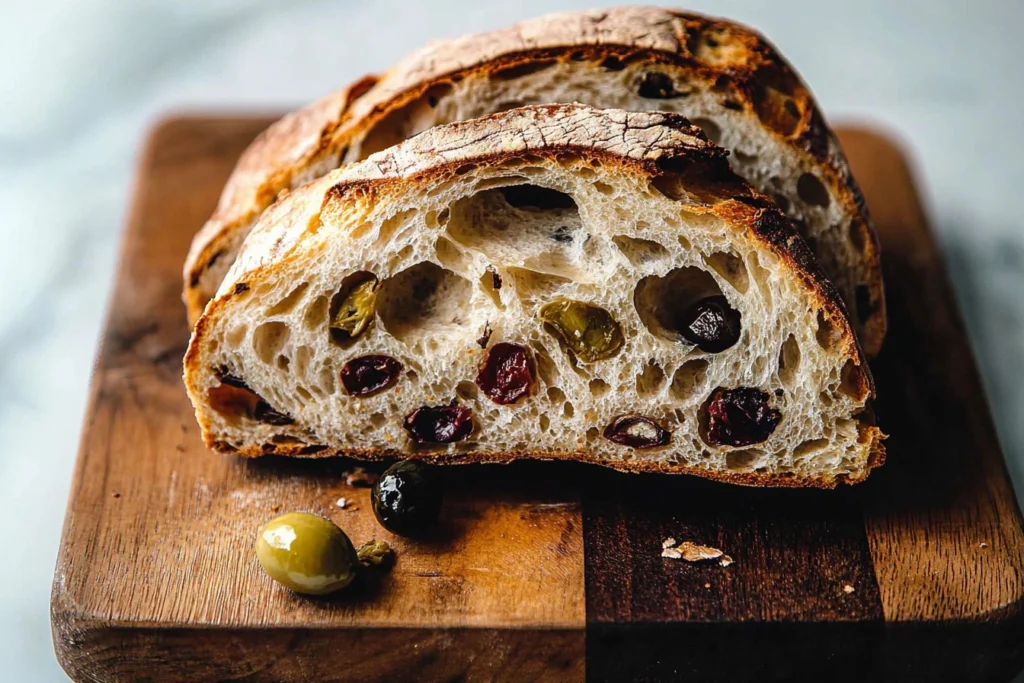If you love baking bread, you must try this Kalamata and Castelvetrano Olive Sourdough! It’s a wonderful blend of tangy and savory flavors, making it perfect for any meal or snack. With a crunchy crust and a chewy interior, this bread is sure to impress your family and friends. Plus, the smell of it baking will fill your home with warmth and comfort!
Why Make This Recipe
This recipe is fantastic for anyone who enjoys homemade bread. Adding olives gives it a unique twist that makes it stand out from regular sourdough. It’s perfect for sandwiches, as a side with soup, or simply toasted with a bit of butter. Your family will love it, and you’ll feel accomplished making it from scratch!
How to Make Kalamata and Castelvetrano Olive Sourdough
Ingredients:
- 300 grams unbleached bread flour (plus more for dusting)
- 140 grams 90% extraction wheat flour or whole wheat flour
- 360 grams 90°F/32°C filtered water (divided)
- 90 grams ripe sourdough starter (100% hydration)
- 9 grams Diamond Crystal kosher or fine sea salt
- 75 grams pitted Castelvetrano olives (sliced in half)
- 75 grams pitted Kalamata olives (sliced in half)
- White rice flour (for dusting your banneton basket)
Directions:
-
Please read through the blog post for additional notes and step-by-step photos before proceeding. You can also find an example baking timeline below the instructions.
-
IMPORTANT NOTE: Many sourdough recipes require a separate starter for baking. I like to use a portion of my ripe, just-peaked starter. This saves time and fits better with my feeding schedule. You can adjust this method to match your own schedule.
-
Autolyse: In a large mixing bowl, combine 300 grams of unbleached bread flour and 140 grams of 90% extraction wheat flour. Add 350 grams of filtered water at 90°F/32°C and mix with your hands until fully combined with no dry bits. Cover with a clean shower cap or plastic wrap, and let it rest at 78°F/25.5°C for 1 hour and 30 minutes.
-
Add Starter and Rest: Add the remaining 10 grams of water and the 90 grams of ripe sourdough starter. Use your fingertips to spread the starter over the mixture, then fold the dough until the starter is well incorporated. Cover and let it rest at 78°F/25.5°C for 30 minutes.
-
Add Salt and Rest: Sprinkle 9 grams of salt over the dough. Pinch and mix until you can’t feel any salt granules. Cover and let it rest at 78°F/25.5°C for 15 minutes.
-
Bulk Fermentation: Perform 3 sets of stretch and folds during the first 45 minutes of bulk fermentation. Each set should be 15 minutes apart. The dough won’t rise during this step but will strengthen. Wet your hands to avoid sticking.
-
Lamination (Adding the Olives): After the last stretch and fold, rest for 30 minutes. Lightly spritz your work area with water. Transfer the dough onto the surface and stretch it into a large rectangle. Spread the halved olives evenly over it.
-
Envelope Fold: Fold the dough like an envelope, first from the sides, then the top and bottom. Flip seam side down and shape it into a loose round. Cover and rest at 78°F/25.5°C.
-
Bulk Fermentation Continued: After lamination, let the dough rest for about 45 minutes. Perform two coil folds every 30 minutes. Rest covered until it feels lively and has bubbles, around 1.5 – 2 hours.
-
Pre-Shape: Gently transfer the dough onto a clean counter. Shape it into a round, pulling it towards you to create surface tension. Let it rest for 15 to 20 minutes.
-
Final Shape: Dust a banneton basket with white rice flour. Flip the dough and shape it into a round or batard. Place it in the banneton seam side up. Cover with a kitchen towel and place in a plastic bag.
-
Final Proof: Refrigerate the basket for 15-16 hours at 38°F/3°C. This slow fermentation develops flavor and improves crust texture.
-
Preheat the Oven: Preheat your baking vessel at 500°F/260°C for at least 1 hour.
-
Transfer and Bake: Carefully invert the dough onto parchment and score the top. Place it in the preheated pan, cover, and bake for 25 minutes at 500°F/260°C.
-
Remove the Lid: After 25 minutes, the dough should have risen. Lower the oven temperature to 475°F/240°C and continue baking uncovered for 15-25 minutes or until the crust is deep golden.
-
Cool: Transfer the bread to a cooling rack. Let it cool completely before slicing. This will take several hours, but it’s worth the wait!
How to Serve Kalamata and Castelvetrano Olive Sourdough
You can enjoy this soured loaf fresh with butter, or use it to make tasty sandwiches. It pairs wonderfully with soups or salads. Serve it sliced as an appetizer with some olive oil for dipping. Your family and friends will be asking for more!
How to Store Kalamata and Castelvetrano Olive Sourdough
To keep your sourdough fresh, place it in a paper bag or wrap it in a clean kitchen towel. This allows it to breathe without getting too hard. If you want to keep it longer, slice and freeze pieces for easy access later. Just toast them directly from frozen!
Tips to Make Kalamata and Castelvetrano Olive Sourdough
- Use room temperature water for easier mixing.
- Make sure your sourdough starter is bubbly and active for the best rise.
- Don’t rush the resting periods; this helps develop flavor and texture.
- Practice folding techniques to find what feels best for you.
Variation
You can add different types of olives or herbs like rosemary to change up the flavor. Feel free to experiment and make this recipe your own!
FAQs
-
Can I use different olives?
Yes! You can swap out different olives based on your taste preference. -
How do I know if my starter is ready?
Your starter is ready when it is bubbly and has doubled in size within 4-6 hours after feeding. -
What if my dough is too sticky?
If the dough is too sticky, try wetting your hands when handling it. Avoid adding too much extra flour, as it can change the dough texture.



